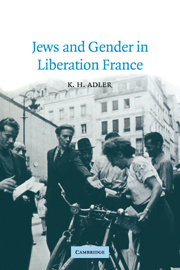Book contents
- Frontmatter
- Contents
- List of illustrations
- Abbreviations
- Acknowledgements
- 1 Introduction: the long liberation
- 2 Narrating liberation
- 3 Anticipating liberation: the gendered nation in print
- 4 Limiting liberation: ‘the French for France’
- 5 Controlling liberation: Georges Mauco and a population fit for France
- 6 Liberation in place: Jewish women in the city
- 7 Conclusion
- Notes
- Bibliography
- Index
- Studies in the Social and Cultural History of Modern Warfare
1 - Introduction: the long liberation
Published online by Cambridge University Press: 04 July 2009
- Frontmatter
- Contents
- List of illustrations
- Abbreviations
- Acknowledgements
- 1 Introduction: the long liberation
- 2 Narrating liberation
- 3 Anticipating liberation: the gendered nation in print
- 4 Limiting liberation: ‘the French for France’
- 5 Controlling liberation: Georges Mauco and a population fit for France
- 6 Liberation in place: Jewish women in the city
- 7 Conclusion
- Notes
- Bibliography
- Index
- Studies in the Social and Cultural History of Modern Warfare
Summary
I remember the day I saw the first Germans … there was a rumour, we went down to the street and I saw the motorized troops arrive. It was a sort of grey-green block. It was sparkling, it was backfiring, it was bellowing. They turned the corner of the road … and in my mind … it was death which advanced.
To begin with, was the invasion. Six weeks later came the defeat, followed by four years of occupation. Riven into pieces (map 2), France was at war with the occupiers and with itself. The government, democratically elected in 1936, ‘committed suicide’ when those parliamentarians still left in the chamber of deputies — the communists had already been banned and other opponents to the occupation had fled — voted full powers to the veteran First World War marshal, Philippe Pétain. He and his collaborationist government would rule with a brand of Catholic, racist, technocratic and anti-feminist authoritarianism framed by what was posited as a return to authentic French values, in order to wrest the nation from the grip of decadence to which it had succumbed. For the first two years, a large proportion of the population supported Pétain and his National Revolution.
- Type
- Chapter
- Information
- Jews and Gender in Liberation France , pp. 1 - 6Publisher: Cambridge University PressPrint publication year: 2003



